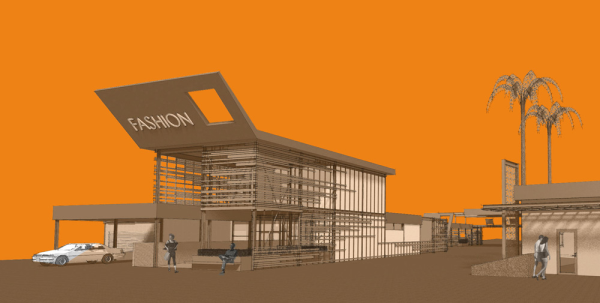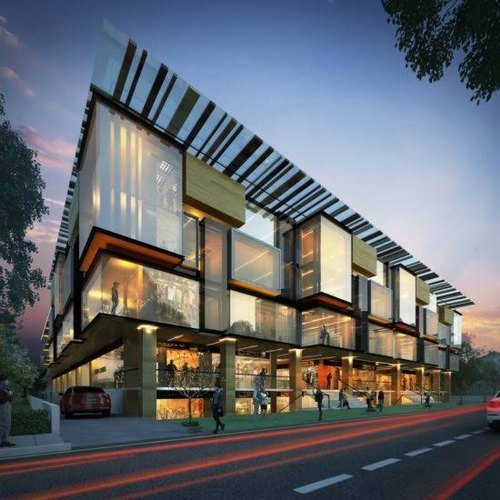Unveiling the Comprehensive Solutions Offered by Commercial Architects for Modern Advancement
Commercial Architects serve a crucial feature in modern advancement projects. They mix style appearances with capability while adhering to regulatory requirements. Their expertise expands beyond mere building and construction, integrating lasting practices and ingenious modern technologies. As they navigate complex zoning laws, Architects work together with various stakeholders to bring visions to life. This complex technique increases inquiries regarding the developing function of Architects fit contemporary areas and the influence of their work on future developments.
Recognizing the Duty of Commercial Architects in Modern Developments
In contemporary city landscapes, Commercial Architects play a vital function in forming functional and aesthetic spaces that satisfy varied company needs. Their know-how extends beyond simple layout; they navigate intricate zoning regulations, building codes, and ecological regulations. By working together with customers, they identify particular demands, ensuring that each project aligns with the customer's vision while likewise taking into consideration practical aspects such as sustainability and cost-effectiveness. Commercial Architects are experienced at incorporating innovative modern technologies and materials right into their styles, improving both the performance and power performance of structures. They perform detailed site analyses to evaluate the prospective challenges and possibilities provided by an area. In addition, efficient communication with professionals and other stakeholders is important, guaranteeing that the project progresses smoothly from perception to conclusion. Ultimately, Commercial Architects are instrumental in creating areas that not only accomplish practical purposes but also add to the overall character and vibrancy of urban environments.
Idea Design: Changing Concepts Into Fact
Principle layout acts as a crucial phase in Commercial architecture, where innovative layout remedies arise from imaginative thinking. This procedure relies upon collective ideation, uniting varied viewpoints to fine-tune and enhance initial principles. As ideas form, they change from abstract notions right into tangible building realities.
Cutting-edge Style Solutions
Transforming ideas right into reality is the characteristic of ingenious design options in Commercial style. These options mix creativity with capability, resolving the special requirements of modern developments. By leveraging sophisticated innovations and sustainable techniques, Architects craft areas that are not only aesthetically appealing however also reliable and versatile. Emphasis on individual experience drives the style process, making certain that environments foster performance and cooperation. Each task take advantage of a customized strategy, where ideas are meticulously created to show the customer's vision while thinking about future fads. Innovative design remedies likewise focus on flexibility, enabling modifications with time as business requirements advance. Ultimately, these approaches boost the general value of Commercial rooms, making them essential in today's competitive landscape.

Collaborative Ideation Process
Partnership works as the foundation of the ideation process in Commercial design, fostering creativity and innovation amongst diverse stakeholders. Architects, customers, designers, and area participants participate in vibrant discussions, guaranteeing that all perspectives are taken into consideration. This inclusive method enables for the exploration of numerous layout principles, urging special services that line up with the project's vision. With workshops and brainstorming sessions, ideas evolve and improve, transforming first ideas into tangible layouts. Modern technology additionally plays a crucial function, with tools such as Structure Information Modeling (BIM) assisting in real-time collaboration and adjustments. Ultimately, this joint ideation process not just improves the layout result however likewise grows a feeling of ownership and financial investment among all parties involved, leading to successful Commercial advancements.
Zoning Analysis: Browsing Regulations and Conformity
As designers commence on brand-new tasks, understanding zoning policies is necessary to ensuring compliance and avoiding pricey hold-ups. Zoning evaluation plays a vital role in this process, as it includes evaluating regional zoning regulations that determine land use, constructing elevation, density, and problems. Commercial Architects have the know-how to browse these complicated policies, helping customers recognize allowable uses and any needed variances.
Sustainable Layout Practices: Structure for the Future
Lasting style methods are progressively necessary in the domain of Commercial style, particularly as environmental issues continue to escalate. Architects focus on environment-friendly products, energy-efficient systems, and style methods that minimize waste and environmental effect. Incorporating renewable resource sources, such as solar panels and wind generators, allows buildings to produce their very own power and lower reliance on fossil fuels.Furthermore, sustainable design emphasizes the significance of indoor ecological high quality. This consists of making use of all-natural light, improving ventilation, and picking non-toxic materials to enhance resident health and wellness and performance. Green roof coverings and living wall surfaces are additionally preferred features that add to biodiversity and urban cooling.Additionally, Commercial Architects often incorporate water preservation methods, like rainwater harvesting and drought-resistant landscaping. Through these ingenious methods, they develop spaces that not just satisfy modern requirements however likewise cultivate a lasting future, resolving the growing need for liable growth in the contemporary world.
Project Monitoring: Ensuring Timely and Effective Implementation
Efficient project monitoring is crucial for making sure that Commercial architecture tasks are finished in a timely manner and within budget. This duty encompasses a series of responsibilities, consisting of the coordination of numerous stakeholders, timelines, and resources. Commercial Architects utilize their expertise to produce thorough project strategies that outline crucial milestones and deliverables, enabling organized progress tracking.Regular communication amongst staff member and clients is vital, cultivating transparency and facilitating timely decision-making. Threat management techniques are additionally employed to determine prospective obstacles early, allowing aggressive remedies to be created. By using innovative job management devices, Architects can keep track of job efficiency in real-time, making modifications as essential to preserve effectiveness.
Interior Style: Developing Practical and Aesthetic Spaces
Interior style plays a vital duty linked here in enhancing both functionality and appearance within Commercial spaces. Effective room planning can enhance process and enhance individual experience, while visual design principles add visit this website to a visually enticing environment - commercial architects. Together, these elements develop rooms that are not only sensible but also motivating
Space Planning Performance
While maximizing the utility of offered area, Commercial Architects focus on space preparation efficiency to produce both practical and visually pleasing environments. This technique includes careful evaluation of the spatial design to guarantee perfect use every square foot. Architects consider variables such as operations, access, and all-natural light to enhance use. By tactically placing furnishings, tools, and workstations, they facilitate movement and communication amongst customers, advertising productivity. Additionally, zoning various areas for details functions helps in managing sound and personal privacy, creating a harmonious atmosphere. With efficient space preparation, Commercial Architects can transform restrictions into opportunities, guaranteeing that each area meets the varied demands of its passengers while adhering to governing requirements and industry standards.
Visual Style Principles
Aesthetic design concepts play a necessary role fit environments that are not only functional however additionally aesthetically attractive. These principles guide Commercial Architects in producing rooms that reverberate with customers while enhancing brand identity. Trick aspects consist of balance, proportion, and harmony, which function with each other to develop a cohesive appearance. Color plans and products are carefully chosen to stimulate desired emotions and support the total style. Additionally, lights plays a critical function, influencing mood and exposure while highlighting architectural attributes. By incorporating these principles, Architects guarantee that spaces are not only sensible however likewise inviting and inspiring. Ultimately, efficient visual layout cultivates a positive customer experience, encouraging engagement and contentment in Commercial atmospheres.
Cooperation With Stakeholders: Cultivating Effective Collaborations
Effective partnerships in Commercial design rest on efficient cooperation with stakeholders, making certain that every voice is listened to and valued. This joint technique includes appealing different celebrations, including customers, professionals, and community members, throughout the design and advancement procedure. By cultivating open interaction, Commercial Architects can attend to issues, gather insights, and line up the project's vision with stakeholder expectations.The combination of varied perspectives improves creativity and advancement, causing even more useful and cosmetically pleasing designs. Routine conferences, feedback sessions, and workshops promote this discussion, allowing Architects to adjust their strategies in reaction to stakeholder input. In addition, developing count on through transparency and liability reinforces these collaborations, causing a smoother official website task execution.Ultimately, the success of modern growths depends on the Architects' ability to browse and harmonize varying rate of interests, developing a joint atmosphere that promotes common goals and mutual success.
Frequently Asked Concerns
How Do Commercial Architects Handle Budget Constraints During a Project?

What Kinds of Software Program Do Commercial Architects Typically Utilize?
Commercial Architects frequently make use of software application such as AutoCAD for composing, Revit for Structure Information Modeling, SketchUp for 3D modeling, and project administration devices like Microsoft Project to enhance partnership and enhance operations throughout the style process.
Can Commercial Architects Assist With Acquiring Financing for Projects?
Commercial Architects can assist in getting financing for projects by preparing detailed propositions, assisting to articulate style visions, and supplying monetary forecasts that can improve the probability of safeguarding essential financing from financiers or banks.
Just How Do Architects Make Certain Safety During the Building Refine?
Architects ensure safety throughout construction by applying extensive design requirements, collaborating with engineers, performing routine site inspections, sticking to local policies, and promoting communication amongst all stakeholders to alleviate dangers and advertise a safe working atmosphere.
What Recurring Assistance Do Architects Provide After Job Conclusion?
After project conclusion, Architects supply continuous support via upkeep appointments, performance evaluations, and layout modifications. They guarantee structures fulfill developing demands, address possible issues, and keep compliance with guidelines, promoting a lasting partnership with clients.